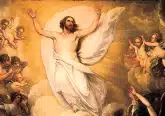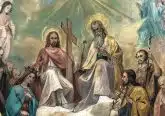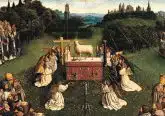Introducing “Eschatological” Man

Note: This article is part of an ongoing series on Pope St. John Paul II’s “Theology of the Body” (TOB).
Up to this point in our reflections on TOB, we have been exploring Pope St. John Paul II’s reflections on “original man” and “historical man.” “Original man” refers to the integral, harmonious state of our first parents before sin entered the world. In reflecting on “original man,” we explored what John Paul II called the “original experiences” as well as the spousal meaning of the body and the meaning of nakedness without shame.
“Historical man” refers to the state of humanity wounded by sin but redeemed by Christ and called to holiness through the power of the Holy Spirit. Our reflections on historical man have followed the saintly Pope’s meditations on concupiscence, shame, adultery in the heart and our calling to purity of heart.
After reflecting on our original and historical states, Pope St. John Paul II moved on to the third part of what he called his “triptych” on the human person. A triptych is a three-paneled work of art, often depicting three distinct scenes related by a common theme. In TOB, the Pope used the term triptych to refer to his meditations on the three states of human existence: original, historical and eschatological. His reflections on “eschatological man” are meant to complete his triptych—his threefold reflection on the human person.
But what does “eschatological” mean? This theological term refers to what Bible scholar Dr. Brant Pitre calls the seven last things: death, judgment, heaven, hell, purgatory, the resurrection of the body and the new creation (i.e., the new heavens and new earth). Many Catholics are unfamiliar with what our Faith teaches on these final and incredibly important matters, especially the resurrection of the body and the new creation. We often think the goal of the Christian life is to go to heaven when we die, by which we mean that our souls live on in a blissful, spiritual state in God’s presence while our bodies decay here below. While this view is partly correct, it is important to emphasize that living in a spiritual state as a disembodied soul after death is not the hope of the Christian.
Sacred Scripture and Church teaching are quite clear that the final hope of the Christian is the resurrection of the body and the new creation in which we will live forever in perfect union with God and one another as incarnate beings. Indeed, at the end of the Apostles Creed we profess belief in “the resurrection of the body and life everlasting.” Similarly, the Nicene Creed we commonly profess at Mass ends with the declaration, “I look forward to the resurrection of the dead and the life of the world to come.” These doctrinal statements remind us that human beings are always intended by God to be a unity of body and soul. It is our unique place in the cosmos to unite within us the visible, material dimension of creation and the personal, spiritual dimension. Only human beings can do this, and it is central to our identity and our vocation in this life and the next.
Death, which is the separation of body and soul, entered into the human drama because of sin. It is a horror, an abomination for our human nature to be ripped apart in this way. While we do believe that God has created our souls to be immortal such that He continues to hold them in existence when separated from the body, the state of the separated soul after death is unnatural and incomplete. Even the souls admitted into God’s heavenly presence after death long to be reunited with their bodies so that they can once again be complete, incarnate human persons as God intends us to be. This, in fact, is our ultimate destiny. We will continue with the help of Pope St. John Paul II to reflect on how the reality of final resurrection enlightens our understanding of the human body, marriage and sexuality.
 Dr. Andrew Sodergren, MTS. PSY.D is a Catholic psychologist and director of psychological services for Ruah Woods. He speaks on the integration of psychology and the Catholic faith. He and his wife, Ellie, have five children.
Dr. Andrew Sodergren, MTS. PSY.D is a Catholic psychologist and director of psychological services for Ruah Woods. He speaks on the integration of psychology and the Catholic faith. He and his wife, Ellie, have five children.
This article appeared in the October 2024 edition of The Catholic Telegraph Magazine. For your complimentary subscription, click here.













